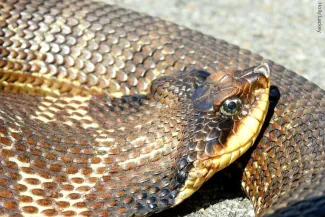Shorter days and cooling temperatures are signals for many Oklahomans to break free of their summer routines and begin preparations for upcoming hunting seasons or fall camping trips. But our state's outdoorsmen and women aren't the only ones taking advantage of the changing seasons. Fall temperatures also factor into increased activity, or a "second spring," in Oklahoma's reptile community.
Reptiles are considered ectotherms (formerly known as cold-blooded animals) and aren't able to regulate their body temperatures. Instead they rely on external heat sources to keep warm. Outside temperatures in the 60s and 70s give these animals a chance to warm up, but not overheat. This often leads to a second peak of activity before it gets cold and many reptiles go dormant.
A Closer Look at One Fall-Loving Reptile
The hog-nosed snake is just one of many Oklahoma reptiles experiencing a second peak of activity in the fall.

These snakes can have a highly variable appearance, ranging from a tan background color to black, and from a blotched pattern to solid. Regardless of color or pattern, hog-nosed snakes have a distinctive upturned nose. These snakes can reach 3 feet in length and feed primarily on amphibians, especially frogs and toads. Hog-nosed snakes may be best known for their impressive defensive displays. If threatened, these snakes can perform award-worthy death scenes. In addition to convulsing and feigning death, hog-nosed snakes may also hiss and inflate their head and neck as a defense.
Three hog-nosed snake species can be found in Oklahoma; the eastern hog-nosed snake, plains hog-nosed snake and dusty hog-nosed snake. The eastern hog-nosed snake can be differentiated from both the plains hog-nosed snake and dusty hog-nosed snake by the unmarked underside of its tail.
Have a memorable hog-nosed snake encounter or fun photo? Share your memories with us @OKWildlifeDept!